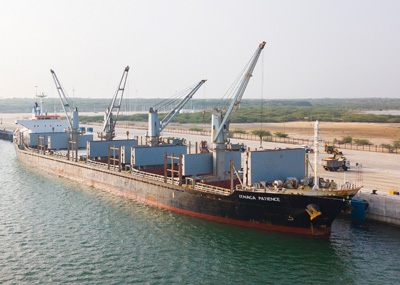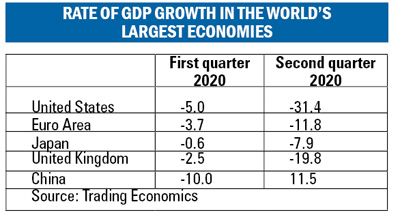China after 71 years
View(s): It was the celebration of the 71st National Day of China in Colombo too in commemorating the establishment of the People’s Republic of China on October 1, 1949. The event was organised by the Sri Lanka China Society on Monday at the BMICH. At this occasion, I was invited to deliver the Keynote Speech on “Sri Lanka’s Post-COVID Economic Progress and China-Sri Lanka Relations”. Today, I felt that I must write on some of the key points extracted from this speech.
It was the celebration of the 71st National Day of China in Colombo too in commemorating the establishment of the People’s Republic of China on October 1, 1949. The event was organised by the Sri Lanka China Society on Monday at the BMICH. At this occasion, I was invited to deliver the Keynote Speech on “Sri Lanka’s Post-COVID Economic Progress and China-Sri Lanka Relations”. Today, I felt that I must write on some of the key points extracted from this speech.
Independent Sri Lanka and the People’s Republic of China became close friends in the early years at that time. Sri Lanka was one of the first few non-communist countries to recognise the People’s Republic of China as early as in 1950. The two countries also entered into the famous Rubber-Rice Pact in 1952, which lasted for 30 years and, then, became naturally redundant under different circumstances. China stood with and stood by Sri Lanka all the time throughout history, at both good times and difficult times.
1948 and 1977
What was interesting to me was the story between the two countries centred around two points: The first is that Sri Lanka received Independence from Britain in 1948 – one year before the establishment of the People’s Republic of China. The second is that Sri Lanka commenced its market-oriented policy reforms in 1977 – one year before China commenced its policy reforms.
At that time, China was poorer than Sri Lanka; according to World Development Indicators of the World Bank group, China’s per capita income was US$200, compared to $240 in Sri Lanka. Being the most-populated country in the world, China’s extreme poverty is a well-known story. As the size of the population appeared to be too much in the context of extreme poverty, the Chinese government even enacted an aggressive “one-child policy” in 1979 in order to control population growth which continued to add merely to the poverty issue.
Then the miracle began in China after 1980 with a purposive and consistent policy reform process. While the average annual rate of growth remained about 10 per cent until the recent years, its miraculous economic growth has enabled China to lift more than 850 million people out of extreme poverty. China is now the world’s second largest economy which contributes to 15 per cent of the world GDP. With the current rate of GDP growth supported by the “global vision” of the leadership materialised with continuous policy reforms, China’s march towards becoming the world’s largest economy is just a matter of time.
With over $10,000 per capita income, today China is an “upper-middle income” country although it is still a “quarter” of the average for high-income countries. But the Chinese economy is still growing at a higher rate than that of high-income countries so that reaching the “high-income” status is also a matter of time. As far as the current poverty levels are concerned, 350 million people which is about a quarter of the 1.4 billion live below the “upper-middle income poverty line” of $5.50 a day. But again, it is a matter of time before China has a plan to lift them out even above the upper-middle income poverty line.
Development fundamentals
The five largest economies in the world – the US, Euro area, Japan, the UK and China -, together account for two-thirds of the world GDP. All these economies have plummeted into a deep recession due to the COVID-19 pandemic issue, but among them only China has already got out. As it appears now, among the five largest economies in the world, it is only China which is likely to have a positive rate of GDP growth in 2020.
China’s continued support is important. Perhaps, its global economic vision which creates opportunities for other countries in the region is important too. Much more than all these, there is another dimension which is far more important – that is, learning from China. China’s success story is a unique one in the world, which can provide many lessons to others. We need to avoid misunderstanding that it is not the “Chinese model” which is likely to be replicated anywhere else. Neither is it about the advantageous conditions that China alone enjoys. But there are unique advantageous conditions that others enjoy too. It is all about few key lessons that the Chinese economic miracle exhibits.

File picture of the Hambantota Port, built and managed by the Chinese.
First and foremost is China’s massive export growth which sustained its economic growth. At the time of initiating policy reforms in 1978, China’s exports amounted to $10 billion only, which has now increased to $2,500 billion. Why exports? It is because “the progress is limited by the size of the market”. And the size of the domestic market of any country, including that of China, is too small to sustain expansion. International markets which have no boundaries allow an “unlimited expansion path” for industries on the one hand and provides opportunities to reap the “cost advantage of operational scale” on the other hand. Economic growth cannot be higher and sustained over the years without export growth.
The second is the fact that export growth requires investment and that domestic saving is too small to sustain a massive investment drive. China didn’t take it as a problem, because it provided the world’s “best investment centre” for foreign investment. Until 1978, there was no foreign investment reported in China; it started with just $50 million in 1980 but increased constantly reaching $50 billion by 2002. Over the past 10 years, China’s foreign investment continued to remain well above $100 billion a year, reporting to be the world’s largest foreign investment recipient country. A large part of foreign investment was of the so-called “footloose” type too which didn’t have much backward and forward integration to the domestic economy. Sometimes, they were only “assembling activities” but they created millions of jobs and added to the country’s exports although their domestic value addition was small.
In China too, poverty is largely in the over-populated remote rural sector where many people live in harsh conditions, engaging in unproductive agriculture activities. Still about 40 per cent of people in China live in the rural sector, which is significantly higher than that of upper-middle income countries. As countries become richer, rural populations should decline contributing to higher agriculture productivity back in the rural areas and feeding into industry and service sectors in the urban areas.
In its urban planning exercises, China has taken steps to move rural people into urban settlements without waiting for it to happen as a natural outcome of the development process, which would expedite the development drive. It would bring rural people out of poverty and allow them to engage in more productive jobs in the industry and service sectors.
Replicable system?
What makes the Chinese miracle different is that it has identified growth drivers – both direct and indirect drivers and focused on activating them.
Many would have an excuse to say that what and how China did cannot be repeated. I agree, but its development fundamentals are the same everywhere and they are less-ambiguous today than ever before. Why many countries fail to establish such development fundamentals are not because they don’t have a political system as in China. Unless they don’t understand these fundamentals, it’s because they don’t have the political will and integrity in order to strengthen their policy-making capacity. In fact, it is even easier and quicker for small countries than for big countries to become developed.
(The writer is a Professor of Economics at the University of Colombo and can be reached at sirimal@econ.cmb.ac.lk and follow on Twitter @SirimalAshoka).



